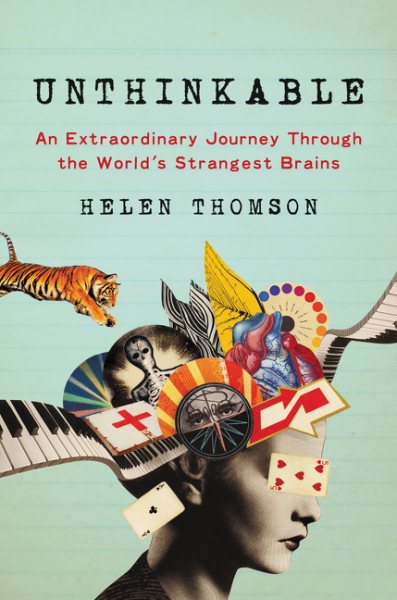“Does my world look like yours?” Helen Thomson asks this in Unthinkable: An Extraordinary Journey Through the World’s Strangest Brains. I really surprised myself when I picked this book up. The two psychology classes I took in high school were interesting, but that was the last time I thought about the brain.  But when I looked at Unthinkable when we got them in, the cover just grabbed ahold of my attention. Each chapter focuses on a real person from around the world and the rare brain disorder they have. The chapter that made me buy this book is about a man named Graham who, for three years, believed he was dead. Objectively, he knew he wasn’t. He was able to walk and talk and tell the doctor he was “dead,” but for some reason, his brain wasn’t letting him grasp that he was alive.
But when I looked at Unthinkable when we got them in, the cover just grabbed ahold of my attention. Each chapter focuses on a real person from around the world and the rare brain disorder they have. The chapter that made me buy this book is about a man named Graham who, for three years, believed he was dead. Objectively, he knew he wasn’t. He was able to walk and talk and tell the doctor he was “dead,” but for some reason, his brain wasn’t letting him grasp that he was alive.
A lot of the people featured in this book have a disorder known as synesthesia. Synesthesia is a phenomenon in which the activation of one sense will also trigger a second sense. In the book, Ruben is a man that associates colors with people in an almost aura-like sense. Different colors mean different things to him, for example, he associates red with things he likes. A famous synesthete was Vladimir Nabokov who had grapheme-color synesthesia, where he saw specific letters in specific colors. In his own words, “The long a of the English alphabet….has for me the tint of weathered wood, but a French a evokes polished ebony. I am puzzled by my French on which I see as the brimming tension-surface of alcohol in a small glass… In the brown group, there are the rich rubbery tone of soft g, paler j, and the drab shoelace of h.”
The most interesting chapter to me was about Sharon, who would get completely lost in her own house. Since the age of 5, Sharon’s world would completely flip around to where she couldn’t figure out where she was. She soon realized this was happening whenever she spun around quickly or took a curvy road to her destination. At a party, when she was young, though, she figured out that the trick to right everything around her was to spin around again. Sharon calls this her Wonder Woman impression. For a long time, she was ashamed of this condition. At age 5, her mother told her not to tell anybody about this, or “they’ll say you’re a witch and burn you.” For 25 years, she hid this disorder from everyone, even her husband! Finally, in the 2000s, a scientist by the name of Giuseppe Iaria helped her come to terms with her condition.
This book is full of other interesting people, from Bob who remembers every day of his life, to Matar who truly believes he turns into a tiger at night. Thomson does an excellent job of frankly describing these people. The tone of this book could easily be sterile, but there’s a lot of warmth when she speaks of these people, as if they were her friends. In each chapter, Thomson also mentions similar cases, past and present, which I found interesting. As I read Unthinkable, it felt like a friend was telling me all of this over coffee. Even if you only have a passing interest in psychology, you will love this book!


Comments are closed.